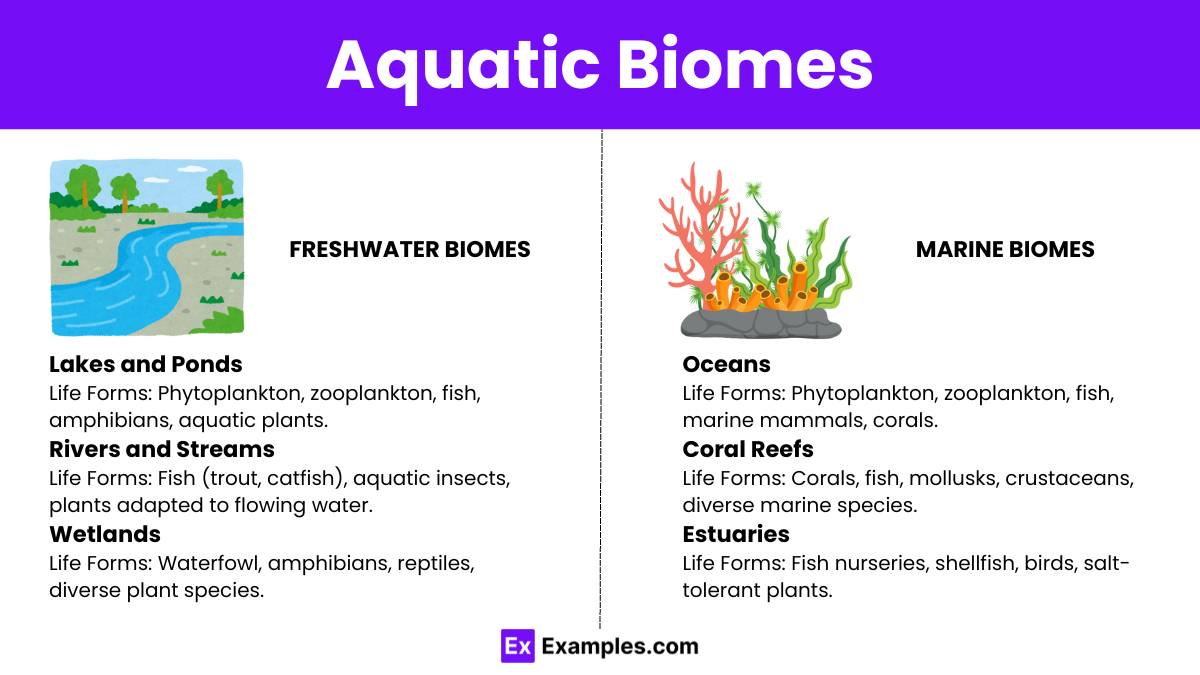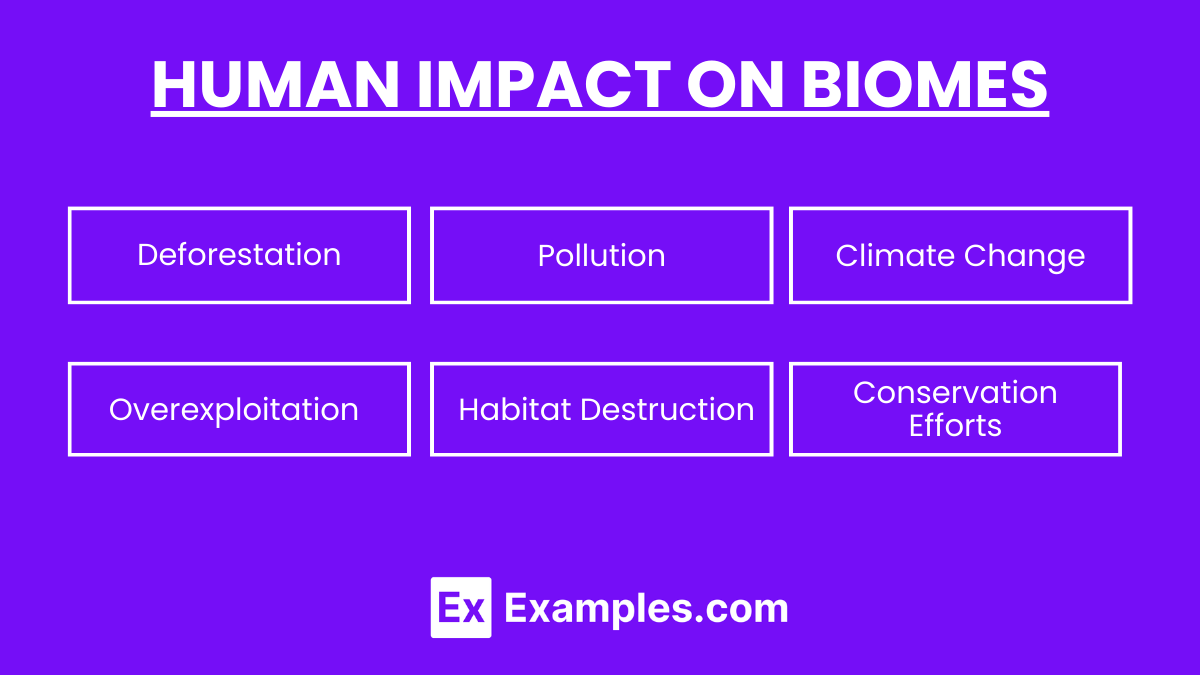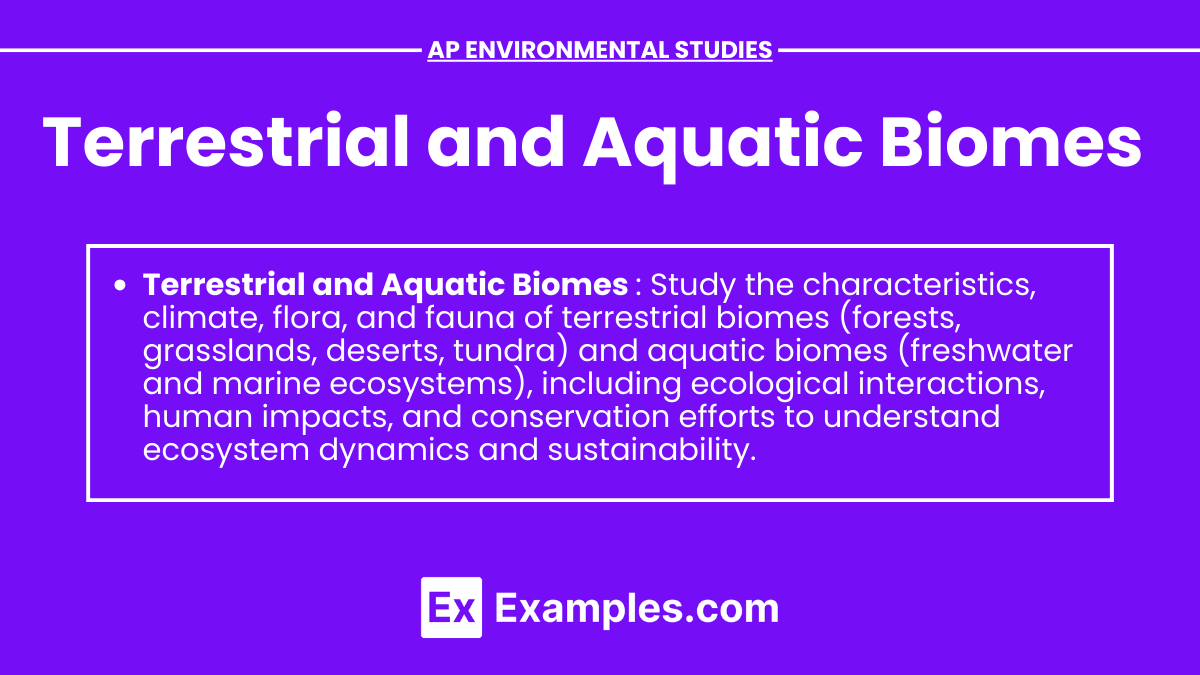Terrestrial and aquatic biomes are large ecological areas defined by their unique climate, geography, and the species adapted to live there. Terrestrial biomes, such as forests, grasslands, deserts, and tundra, are characterized by their vegetation and climate patterns, while aquatic biomes, including freshwater ecosystems like lakes and rivers and marine ecosystems like oceans and coral reefs, are defined by their water type, depth, and salinity. Understanding these biomes involves studying the complex interactions between organisms and their environment, as well as the impact of human activities on these diverse ecosystems.
Learning Objectives
By studying terrestrial and aquatic biomes, students should aim to understand the distinguishing characteristics of each biome, including climate, geography, and predominant flora and fauna. They should be able to explain the ecological interactions within these biomes, such as energy flow and nutrient cycling, and recognize the adaptations that enable species to thrive in different environments. Additionally, students should develop an awareness of the human impacts on these biomes, including habitat destruction, pollution, and climate change, and explore conservation efforts and sustainable practices to protect and restore ecological balance.
Terrestrial Biomes

Terrestrial biomes are distinguished primarily by their vegetation, climate, and location.
1. Tropical Rainforest
- Climate: High temperature (20-25°C), high precipitation (200-400 cm annually).
- Vegetation: Dense canopy, diverse species including broadleaf evergreens, ferns, orchids.
- Fauna: Rich biodiversity, insects, amphibians, birds, mammals.
- Location: Equatorial regions (Amazon Basin, Congo Basin, Southeast Asia).
2. Temperate Deciduous Forest
- Climate: Moderate temperature (4-18°C), distinct seasons, moderate precipitation (75-150 cm).
- Vegetation: Deciduous trees (oaks, maples), shrubs, herbs.
- Fauna: Deer, bears, small mammals, birds, insects.
- Location: Eastern North America, Europe, East Asia.
3. Taiga (Boreal Forest)
- Climate: Cold temperatures (-5 to 5°C), moderate precipitation (40-100 cm, mostly snow).
- Vegetation: Coniferous trees (spruce, pine, fir), low biodiversity.
- Fauna: Moose, bears, wolves, lynx, birds adapted to cold.
- Location: Northern Hemisphere (Canada, Russia, Scandinavia).
4. Savanna
- Climate: Warm temperature (20-30°C), seasonal rainfall (50-150 cm).
- Vegetation: Grasses, scattered trees (acacias), drought-resistant plants.
- Fauna: Large herbivores (elephants, zebras), predators (lions, cheetahs), birds.
- Location: Africa, South America, Australia.
5. Grassland (Prairies/Steppes)
- Climate: Temperate to tropical, moderate precipitation (25-75 cm).
- Vegetation: Grasses, few trees, drought-tolerant species.
- Fauna: Grazing animals (bison, antelope), rodents, birds.
- Location: North America (prairies), Eurasia (steppes), South America (pampas).
6. Desert
- Climate: Extreme temperatures (hot and cold), very low precipitation (<25 cm).
- Vegetation: Xerophytic plants (cacti, succulents), sparse vegetation.
- Fauna: Reptiles, small mammals, birds, insects adapted to arid conditions.
- Location: Sahara, Arabian, Mojave, Australian deserts.
7. Tundra
- Climate: Very cold (-34 to 12°C), low precipitation (15-25 cm).
- Vegetation: Low-growing plants (mosses, lichens, shrubs), permafrost.
- Fauna: Caribou, arctic foxes, migratory birds, insects.
- Location: Arctic regions, high mountain tops (alpine tundra).
Aquatic Biomes

Aquatic biomes are characterized by their water type (freshwater or marine), depth, and salinity.
1. Freshwater Biomes
- Lakes and Ponds:
- Zonation: Littoral zone (shore), limnetic zone (open water), profundal zone (deep water).
- Life Forms: Phytoplankton, zooplankton, fish, amphibians, aquatic plants.
- Rivers and Streams:
- Flow: Current influences ecosystem.
- Life Forms: Fish (trout, catfish), aquatic insects, plants adapted to flowing water.
- Wetlands:
- Types: Marshes (non-woody plants), swamps (woody plants), bogs (acidic water, peat).
- Life Forms: Waterfowl, amphibians, reptiles, diverse plant species.
2. Marine Biomes
- Oceans:
- Zonation: Intertidal zone (shoreline), pelagic zone (open ocean), benthic zone (ocean floor), abyssal zone (deep ocean).
- Life Forms: Phytoplankton, zooplankton, fish, marine mammals, corals.
- Coral Reefs:
- Climate: Warm, shallow waters.
- Life Forms: Corals, fish, mollusks, crustaceans, diverse marine species.
- Estuaries:
- Mix of Saltwater and Freshwater: Brackish water.
- Life Forms: Fish nurseries, shellfish, birds, salt-tolerant plants.
Human Impact on Biomes

- Deforestation: Loss of forests for agriculture, urbanization.
- Pollution: Air, water, soil pollution affecting all biomes.
- Climate Change: Global warming affecting temperature and precipitation patterns.
- Overexploitation: Overfishing, hunting, resource extraction.
- Habitat Destruction: Urban expansion, agriculture, industrial activities.
- Conservation Efforts: Protected areas, sustainable practices, restoration projects.


